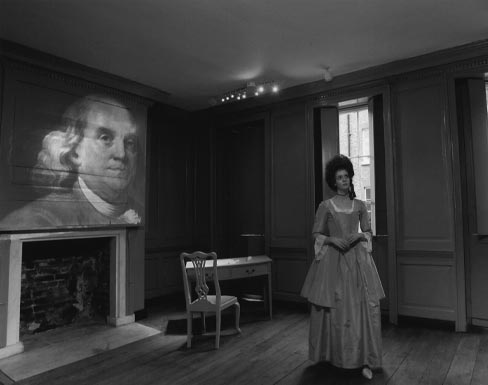Exhibit Review
Benjamin Franklin House: Historical Experience
Benjamin Franklin House, London, United Kingdom Designer: Event Communication, in partnership with Benjamin Franklin House
Permanent
People on both sides of the Atlantic Ocean are celebrating Benjamin Franklin's 300th anniversary with great style. In December 2005, the National Constitution Center in Philadelphia launched a commemorative exhibit, entitled Benjamin Franklin: In Search of a Better World, which is scheduled to travel to St. Louis, Houston, Denver, and Atlanta before heading to Paris, France, in December 2007. In Washington, DC, the Library of Congress mounted an exhibit, Benjamin Franklin: In His Own Words, that explores Franklin's achievements as a writer, publisher, inventor, and statesman through books, cartoons, maps, and other important documents. However, those who want to tread the very boards upon which Benjamin Franklin lived and conducted business as colonial agent, diplomat, writer, philosopher, and scientist will have to travel to London, England, to visit the Benjamin Franklin House, that city's contribution to the Franklin tercentennial celebrations.
Opened in January 2006 for the 300th anniversary, the Benjamin Franklin House is an interpretive challenge, for while it is meticulously restored, it contains no furnishings or other artifacts related specifically to Franklin. To overcome this deficiency, the house takes the approach of interpreting Franklin's London sojourn not as a historic site, but as a historical experience. It relies on an innovative mix of panel exhibits, multimedia effects, and actors in period costume to bring Franklin and the house to life.
Benjamin Franklin first sought lodging with the widow Margaret Stevenson at 36 Craven Street in 1757 and stayed there until the outbreak of the American Revolution in 1775. Built about 1730, the house has been designated a Grade I Listed Building by English Heritage for exceptional significance, similar to the national historic landmark designation in the United States. Recently restored with contributions from the Heritage Lottery Fund and other sources, 36 Craven Street is located a block from bustling Trafalgar Square on a quiet side street of similar, modest, Georgian-style houses.
The experience begins at the nearby Players Theatre, where visitors are assembled into small groups before being led to the house and escorted immediately to the basement to view exhibit panels covering different aspects of Franklin's life. The panels include a timeline, a description of Franklin's role in the Enlightenment, and one on the occupants of 36 Craven Street. Following an introductory video on Franklin's life in London, an actress playing Polly, the landlady's adult daughter, opens the basement door and, in an otherworldly tone of voice, invites the group to visit the rest of the house and share her memories of Franklin.
 |
An actress playing Polly, the adult daughter of Benjamin Franklin's London landlady, guides visitors through 36 Craven Street. (Courtesy of the Benjamin Franklin House.) |
In the first floor parlor, a multimedia show and some furnishings represent a gathering of family and friends. The members of the group hear invisible "guests" banter about political issues of the day and witness the arrival of distinguished individuals. All experience music played on the glass armonica, an unusual musical instrument invented by Franklin while in London. Polly then leads the group upstairs to the two chambers that Benjamin Franklin lived in and used for writing and scientific pursuits. Images and voices fill the rooms, recalling Franklin's inventions, his mapping of the Gulf Stream, his relationship with fellow amateur scientist, the Englishman Joseph Priestley, his study of oxygen, and his unorthodox religious sentiments. Franklin's family life and his extended absence from his wife and children are also addressed in these rooms.
As an agent for the Pennsylvania colony, Franklin found himself embroiled in difficult political negotiations with the British Government while in London. The group watches and listens as he struggles through the controversial Stamp Act of 1765 and colonial resistance to the tax on tea. By 1775, relations between England and the Thirteen Colonies were beyond repair. The visit to the Benjamin Franklin House concludes with Polly urging Franklin to flee. He left England in 1775 and never returned.
As a "historical experience," the Benjamin Franklin House succeeds; however, it has its drawbacks. The time allotted for viewing the exhibits in the basement, for instance, was not sufficient for this reviewer to read all the panels before the orientation video began. Polly's marriage to a well-known doctor of anatomy, William Hewson, and the discovery of a cache of human skeletal remains in the course of restoring the basement are mentioned only in passing. It took a trip to the museum's website to get the whole story. Furthermore, the highly structured and theatrical nature of the historical experience leaves little room for questions from the group or impromptu discussions.
On the other hand, the Benjamin Franklin House experience represents another way of using buildings to tell stories, especially when those stories have little to do with the architecture. Moreover, it brings to life a building that is otherwise devoid of original furnishings, documents, or other physical records of Franklin's time as a resident. Visitors can focus on Benjamin Franklin's own words and those of his contemporaries because they are free of all those polished and upholstered things that are so commonplace in other house museums. Franklin's wit and humanity fill the physically empty rooms, which is perhaps the most appropriate way of remembering him.
Brenda Barrett
National Park Service
